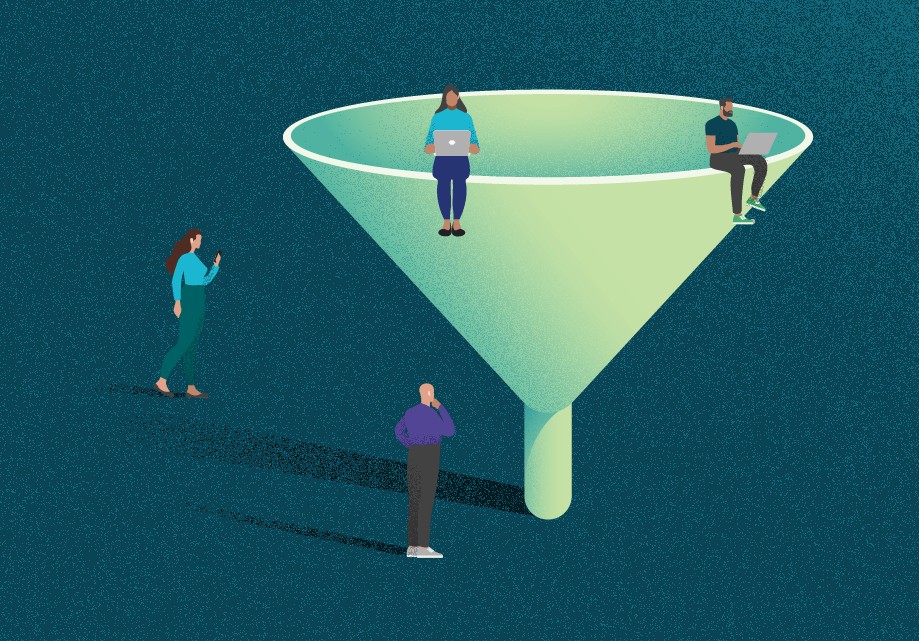If you work in the marketing field, you certainly know very well what leads are.
No? No problem, we’ll explain it properly.
Yes? Continue reading that, after resuming the concept, we will talk about how to qualify leads in your company, achieving better sales results (and this is where the story gets good).
Ready? We will talk about:
Enjoy your reading!
Anyone who has some experience in sales, or comes from an older generation, is used to talking about customers and prospects.
In short, a prospect is a commercial contact that is still being worked on and, therefore, has not yet made any purchases with your company.
Go a few years into the future, and you will see that this same concept has been transported to the reality of Digital Marketing.
Leads are all those consumers who, in some way, keep in touch with your company.
They can be readers of your blog or followers of your company on social media. A lead is more than a visitor — yet they are still not customers.
Your job is to drive this lead down a kind of journey that we call a sales funnel. The lead will learn more about your company, the solutions you have to offer, and your value proposition along this funnel.
In this way, many leads will realize that your company or your product is not exactly what they need, and they will leave the funnel.
And that’s fine! That’s natural.
What we’re really interested in are the leads that get to the bottom of the funnel.
Not only will they make the first purchase, but they will develop a stronger bond with your company because of the process they have gone through.
This means that they become customers who are more loyal and engaged, which increases their probability of returning more often.
What are leads?
Logically, you want the best leads to reach the funnel’s bottom — for example, those with high purchasing potential.
Think about it: you invest a lot of time developing a sales funnel.
It would be a shame if, at the end of it, there were only customers left with a purchase potential of $10 per year. We want the ideal customer, and for that, we need to qualify the leads.
But how do you do it? Well, for starters, let’s explain the three main groups of leads.
We have excellent leads, which have the intention and potential to buy. Intent means they’re ready to buy.
Potential means that they have the means to be good customers (maybe they buy in large volumes, for example).
The excellent leads are also very well-known as qualified leads, but this could cause a little confusion.
It’s important to explain that when we talk about “qualifying leads”, we do not refer to the possibility of turning a bad lead into a great lead.
In fact, qualifying leads is nothing more than identifying the optimal leads for your company.
Then, we have good leads. They have the intent but no potential.
Or, on the contrary, there are also good leads that have potential but no intention to buy — it’s not the right time for them.
These good leads are not a problem. They can stay in the sales hopper longer, until the time is right or become small customers.
Either way, your main sales focus should not be on them, but you can use marketing as a tool to develop them further.
Finally, we have the bad leads. They are bad for you because, although they consume your time, they will not generate any return. Your product is simply not geared towards them, and we’ll teach you what to do with these leads later.
For now, we’ll show you how to qualify your leads properly.
How to qualify your leads
The qualification of a lead depends on a good knowledge of your business, your market, and, mainly, your client.
Why is that?
You can only identify an excellent lead — who has the potential to become the ideal customer — if you know the average profile of an ideal customer.
Of course, the answer will vary greatly according to the type of business you have and the market in which you operate.
The ideal customer in a steel industry does not have the same profile as the ideal customer in a retail store.
So start by building your buyer persona and use your active customers as a reference.
Besides the persona, a second very important element to qualify the leads is the purchase intention.
Remember that the intent to buy can change over time, and, as you have seen, it is possible to have a lead with the right profile (potential) but no intent to buy.
And how do I know if the lead has an intent to buy? Actually, there is a small path that most customers take until they are ready to make the purchase decision.
This path goes through the following steps:
- learning/discovery;
- recognition of the problem;
- solution consideration;
- evaluation and purchase.
If you work with the sales funnel in Content Marketing, you can identify what stage a lead is through the type of content it is consuming.
When the lead starts looking for bottom of the funnel content — equivalent to the final stages of the purchase decision — it’s the moment when they probably intend to purchase.
Depending on the situation, you can still integrate other elements into the lead qualification.
For example, for those who work with B2B sales, the BANT matrix is very interesting. This name is an acronym for Budget, Authority, Need, Timeline.
Note that the authority factor is related to you have the right contact within the company that is your prospect or lead.
For example, if your contact is with the CEO, that person certainly has the authority to make the purchasing decision.
If you don’t have the right contact, you probably won’t convert the lead into a customer even with a great deal of effort.
That’s because that person simply doesn’t have the autonomy to authorize the purchase!
But that kind of criterion wouldn’t necessarily be interesting for a clothing store or a restaurant, since they almost always deal directly with the person who makes the purchasing decision — the end consumer.
Indeed, there are many possible criteria, and not all of them will be useful in your company’s case. Ultimately, you need to develop your own lead qualification method, taking into account the relevant factors to your business.
This method needs to be fast and objective. Imagine that if you have 500 leads to qualify, you can’t spend too much time thinking about each one.
Also, the method should be simple enough for different people on your marketing team to apply.
What to do with excellent, good, and bad leads?
Now, let’s assume three different situations.
Excellent leads
In the first situation, you have a lead with the ideal profile, which is already in the consideration phase of the solution. What can you do in this case?
If possible, it is a good idea to approach it more assertively.
Through direct contact with a sales team (the approach will depend on your company’s profile), the lead will be able to clarify any remaining doubts and make the purchasing decision.
It’s good to highlight that this approach is assertive, not aggressive.
If Content Marketing was done correctly, a good part of the sale was already done before the sales team got in touch with the lead.
What remains to be done is to eliminate the possible obstacles that are still blocking the conversion of that lead.
Good Leads
In the second situation, you have a lead with a low potential profile and who is still at the stage of recognizing the problem.
Should you refer it to the sales team for an approach?
The answer is no.
There simply wouldn’t be a good return on investment of the time and effort to hasten the conversion of this lead.
Instead, you should let it go through the entire funnel and mature the buying decision for itself.
However, you can help this lead by targeting your company’s marketing actions.
Bad leads
In the third situation, you have a lead who’s profile is completely different from your buyer persona, your typical client.
In very general terms, it’s like you have a 50-year-old widowed woman reading the content you write for male, single, 20 to 30-year-old clients.
She may even have some interest in the content you produce, but there will be no conversion into sales.
This lead will not generate a return, so you can “disqualify” it. That means you will not invest in it.
No marketing action by your company will try to “integrate” or “welcome” that lead that is lost there because it is not your target.
Trying to adapt your strategy to turn that lead into a customer somehow would be a complete loss of focus, time, and money.
Keep in mind that for a company, time is the most important resource.
Many companies are afraid to disqualify leads because they think it means a loss of opportunity.
What really matters is not the quantity but the quality of the leads.
It is much better to have 10 qualified leads that will generate 1 million dollars per month, than having 100 leads that will generate that same amount.
When does lead qualification begin?
Since we are talking about the quality of your lead base, we have an important question: from a Content Marketing perspective, at what moment do you think the qualification of leads begins?
The answer may surprise you: the moment the visitor has the first contact with your content!
The more persona-oriented your blog (or other social media) content is, the faster you’ll be able to filter out high-value leads.
So even top-of-the-line content needs to be developed with your ideal customer in mind.
What is the relationship between marketing and sales departments in lead qualification?
You may have noticed that talking about leads and prospects, about Digital Marketing and sales staff, there is no clear dividing line between the marketing and sales departments.
In fact, the work of these two departments is joint.
There needs to be a lot of communication and a certain amount of caution about overlapping roles.
Who receives and qualifies the leads is the marketing, while the commercial team approaches the best ones to make it happen.
What is the relationship between qualified leads and ROI?
Before concluding this article, here is one more piece of information that will certainly interest you greatly.
Did you know that there is a strong relationship between qualified leads and ROI — return on investment — in Digital Marketing?
Many entrepreneurs and managers are afraid to invest in Digital Marketing because they believe that there is no sure way to measure the return on that investment.
However, the qualification of leads is one of the best ways to make such a measurement.
Each qualified lead represents a solid, realistic, and projectable sales opportunity (based on your company’s average sales to customers with an ideal profile).
Therefore, by checking how many qualified leads your Digital Marketing strategy is generating in a given period, you can effectively calculate the ROI in that strategy.
As you can see, lead qualification is the best way to make sure that your company is putting efforts into the right group of prospects.
And to increase your company’s performance even more, check out the best tools that can help you qualify your leads!


![[ROCK NA] [EBOOK SEO] Complete Guide](https://rockcontent.com/wp-content/uploads/2024/06/banner_Search-Engine-Optimization.png)






